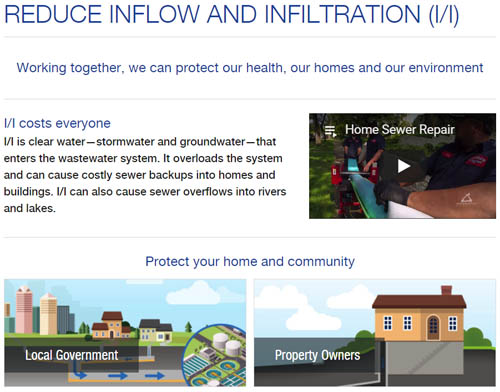Metropolitan Council Environmental Services (MCES) has launched a website with resources for local governments and property owners aimed at reducing inflow and infiltration in the regional wastewater collection and treatment system.
 The site, www.metrocouncil.org/iandi, includes videos, photos, public service announcements, newsletter articles and a detailed handout that communities can use to educate the public about an often-hidden problem that can have costly consequences.
The site, www.metrocouncil.org/iandi, includes videos, photos, public service announcements, newsletter articles and a detailed handout that communities can use to educate the public about an often-hidden problem that can have costly consequences.
The new website grew from the recommendations of a community task force—the 2016 I/I Task Force. The Council asked the group to discuss and identify ways to improve the existing MCES Ongoing I/I Program, as well as discuss the potential for future I/I reduction strategies for both public and private infrastructure. One of the task force’s recommendations was that MCES develop an I/I public outreach program.
“The I/I website is intended to provide a full range of accessible and comprehensive information on addressing inflow-infiltration issues and has tools and information for local governments and property owners,” said Patricia Nauman, executive director of Metro Cities. “Metro Cities believes the new website will prove to be an invaluable part of the I/I toolbox.”
More resources will be added to the site in the future, including a model ordinance for private property service lateral inspection being developed in conjunction with the League of Minnesota Cities and Metro Cities.
I/I is a costly problem for property owners and the region
Inflow and infiltration (I/I) is clear water—stormwater and groundwater—that enters the wastewater system. It overloads the system and can cause costly sewage backups into homes and buildings. I/I can also cause sewage overflows into rivers and lakes.
Communities in the Twin Cities metro area and MCES have been working for decades to address sources of I/I in city and regional sewer infrastructure, like cracked sewer mains and interceptors, and deteriorated maintenance holes. But up to 80% of I/I comes from private property, so fixing those sources is very important.
In addition to sewage backups and overflows, excessive I/I consumes capacity in wastewater conveyance pipes and treatment plants that is needed to accommodate future growth in the region. This wastewater infrastructure is very expensive; the value of regional conveyance pipes, lift stations and treatment plants is estimated at $7 billion. Upsizing this infrastructure to handle I/I is costly and inefficient.
More information
Visit the new I/I website.